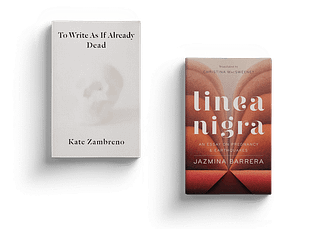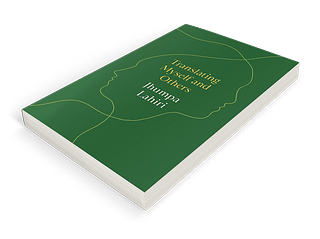
Right now, I have seven translation projects jostling for room in my mind. Some are nearly done, others barely started. Some, I’m actively translating or preparing to translate; others I’m getting ready to pitch to publishers or have begun pitching already. All seven are books I found on my own, through recommendations or research or chance, which means that, when I approach publishers, I’m doing so not only as translator, but as a stand-in agent and scout.
None of this is rare in the world of literary translation, especially when the publishers in question are independent rather than corporate presses. If anything, it’s relatively standard for translators to take on an expanded, labor-intensive role as champions of their authors. But this expansion is rarely discussed in public and rarely compensated. Finding books you love and then advocating for them can take as much energy, and nearly as much time, as the translation itself. In a fair literary world, translators’ rates would reflect all that work.
Of course, in a fair literary world, readers would be paying attention to translators’ curatorial role for other reasons, too. Choosing work to translate is a very concrete manifestation of personal taste. In the United States, at least, if you’re reading a book in translation, unless that book is a Scandinavian thriller or has won some major prizes in its original language, chances are the book only made it into your hands because a translator liked it enough to fight for it. Paying attention to translators’ taste, then, is a way of paying attention to the perennial question of why we get to read the global writers we get to read, and why others may go untranslated.
As of this summer, Open Letter Books, an independent publisher based in Rochester with a history of activism, is directing readers’ attention to precisely this question via an ambitious program called the Translator Triptych. Open Letter releases ten books a year; starting this July, three of those ten will be selected not by the press’s editorial team, but by a translator who will be paid to choose them, will have the option of translating or co-translating all three of them, and will participate actively in promoting them. In theory, the program foregrounds translators’ literary and curatorial expertise. In practice, the inaugural triptych — three contemporary Spanish novels selected by the translator Katie Whittemore — also highlights the translator’s decision-making in a way that reading one translation alone cannot do. Whittemore’s English-language renditions of Sara Mesa’s story collection Bad Handwriting, Lara Moreno’s novel Wolfskin, and Katixa Agirre’s novel Mothers Don’t (which Agirre self-translated from Basque to Spanish) are individually terrific. As a set, they offer a unique way to explore their translator’s interests and style — which, of course, add up to taste.
Bad Handwriting, Wolfskin, and Mothers Don’t share an easily identifiable set of thematic concerns. Mesa’s stories deal with class, femininity, and intellectual life on the margins of a family, a society, or both. Her work can be breathtakingly brutal: in one story, a neighborhood is beset by a wave of grandmothers jumping off apartment-block balconies; in another, a little boy replaces his vanished father with a mannequin found in a dumpster, then tries to take care of his siblings himself. Moreno’s Wolfskin, in comparison, is much less dark. It’s a portrait of a thirty-five-year-old mother, Sofía, who has stifled her impulses toward pleasure, but learns to reclaim them after her husband leaves her. In essence, it’s a book-length exploration of life in a female body. Mothers Don’t, meanwhile, investigates the myth of the bad mother, juxtaposing its unnamed narrator’s conflicting desires to take care of her young son and to write a novel based on the trial of Alice Espanet, a distant acquaintance of hers who, after years of struggling to conceive, drowned her twin infants in the bathtub. Early in Mothers Don’t, Agirre’s narrator notes that to many people, murder is “something men perpetrate against their partners or exes.” In concert, these three books point to a preoccupation with motherhood and femaleness as forms of marginality and vulnerability — but also show a world in which women are perpetrators rather than, or as well as, victims of violence.
In each of Whittemore’s chosen titles, the author deploys prose that isn’t just dark but direct — no flowery or figurative language here. Yet these three writers have very different styles, which is evident in Whittemore’s translations. Mesa is a rough, colloquial writer. Agirre’s prose is journalistically clear. Moreno is more lyrical, but in service of intensity rather than beauty. (I mean that as a compliment: I’ve written elsewhere about my anti-Beautiful Prose agenda.) It is an achievement on Whittemore’s part that she brings these distinctions to the fore in her translations, choosing the smoothest possible translation for sentences in Agirre’s work, for example, while preferring stutter-step or slightly confusing ones in Moreno’s. Of course, to some extent this is simply a matter of adhering to the original text, but a translator cannot produce a stylish translation, or even an artistically decent one, if she mechanically follows an author’s lead. Rhythm and tone, especially, do not simply move over from one language to another: they are holistic effects, built slowly over an entire novel, and have to be created anew — which means that, to create them, a translator has to make some stylistic decisions of their own.
As a not-really-aside, I do know it’s an open question whether a translator can or should have a style, given that one of literary translation’s fundamental goals is to recreate a text’s style in a new language. But translation is an art, and to make art without having or consulting your own stylistic preferences strikes me as impossible. I find it helpful, on this front, to turn to Susan Sontag’s “On Style,” in which she argues that “the matter, the subject [of an artwork], is on the outside; the style is on the Inside.” In the same essay, she defines style, more or less, as “the principle of decision in a work of art, the signature of an artist’s will.” Surely a translator’s will can also be found inside anything they translate, animating the text and powering it to full-fledged life. This seems especially likely, given translation’s inherent reliance on Sontag’s principle of decision: every decision in a translation is doubled. First, you decide whether you’re going to deviate from the literal translation of a word, or phrase, or sentence; then, you decide how far your deviation’s going to go. It seems to me that translation style hides inside this double-decision process. Granted, deviating from the original is, or should always be, a way of preserving the original’s spirit — but translation is a choose-your-own-adventure that way. If a problem pops up, it rarely has one and only one solution. (Hence the common practice of re-translating major works every fifty to one hundred years: the best solution in 1900 is likely not the best one today).
In order to examine Whittemore’s style, then, I went in search of moments that seemed to me like solved problems: words, phrases, or sentences that were strikingly colloquial, that veered from the English-language norm, or that had noticeable commitments to sound. My hunt brought me right back to directness, which, alongside a bracing feminism that looks to the margins, strikes me as the defining trait of Whittemore’s triptych.
Of the books in the triptych, Wolfskin is by far the least direct. Its prose is twisted, tangled, and often repetitive. Commas abound, as do unnecessary rephrasings: a ball of wet tissues, for instance, is “soft and damp, like petals ripped suddenly from a chrysanthemum, from a hortensia.” This style mirrors Sofía’s inner life. At the novel’s start, she’s utterly repressed, shoving down the knowledge that her marriage is dying. Her relationship to her body is hardly in better shape. She controls her diet rigidly, never asks for what she wants, and seems not to have followed an impulse in years. But when her husband leaves abruptly, she panics and, without thinking, takes her young son Leo to spend the summer in her deceased father’s seaside home. Gradually, the beach’s sexy atmosphere starts seeping into Sofía’s inner world, opening her to sensuality, momentum, and chance. Many of Whittemore’s translation decisions prioritize this rhythm over grammar, breaking the rules of standard English in order to create the undertow that helps Sofía progress toward emotional release. Just as many decisions enact the fitfulness of Sofía’s progress. Early in the novel, for instance, Moreno ends a moment of failed connection between Sofía and her sister by writing, “But this opportunity, it vanishes also.” Whittemore could have easily simplified the sentence to the grammatically correct But this opportunity vanishes also — and yet, though that sentence would be technically more direct, adding or retaining the stutter-step it directly communicates Sofía’s hesitation in the moment, her knowledge that she doesn’t know what to do.
Whittemore’s preference for syntactical directness lends itself beautifully to Mesa’s Bad Handwriting, a collection with which I am intimately familiar: years ago, before I knew better than to do this, I translated several of its stories before checking to see if Mesa had a translator already. (Whittemore’s first Sara Mesa translation, the terrifically creepy Four by Four, came out from Open Letter in 2020). Mesa has an almost magical ability to write long sentences that seem short. Her stories use bluntness to devastating effect, both when it comes to the prose itself and in the way she develops characters. Very few authors are willing or able to inhabit protagonists as loathsome as some of Mesa’s: it can be agonizing to spend time with the misogynistic, insecure narrator of “Mustelids,” or to realize, halfway through “White People,” that its main character, a young woman trapped in an awful and thoroughly sympathy-provoking situation, is also a virulent racist. Whittemore’s translations make the reader writhe in a way my drafts never did. Looking back at my old versions, I was struck by the overcomplicated nature of my punctuation: in my efforts to bring Mesa’s long sentences into proper, or proper-ish English, I threw in all kinds of dashes and colons. Whittemore, by and large, trashes propriety and just uses as many commas as it takes. Much of her prose in Bad Handwriting alternates between list-style sentences and devastatingly short, comma-less ones, as in a sex scene in “White People” that starts, “We kissed clumsily. His tongue was rough and sharp. I was assailed by urgency for it to be over. I told him I was staying nearby and suggested he come with me.” Whittemore’s two modes here — to comma and not to comma — are infinitely more successful than my em dashes (which, clearly, are part of my own style). By choosing not to use the full arsenal of tools that the English language offers, she limits herself, yes, but those limits create the direct, straightforward translation that Mesa’s writing demands.
Directness is more crucial still to Agirre’s Mothers Don’t, which is the strongest book in an extremely strong set. Agirre spends much of the novel toying with true-crime tropes, but never once does her nameless protagonist lapse into the melodrama or sentimentality that characterize the genre. At one point, the narrator, frustrated by both Alice’s trial and her own marriage, declares, “If a woman is a mother, sex cannot interfere in her life.” Later, looking at her sick, sleeping son, she describes him, with much pain and zero sentimentality, as “my Achilles heel, an obvious weakness.” Whittemore consistently makes translation choices that highlight the narrator’s straight talk, often — as in Bad Handwriting —ignoring propriety in order to do so. At every turn, she opts for precise but not fancy language, working in English-language colloquialisms (especially, I noted, millennial ones like on brand, which is a subtle way to emphasize how contemporary the story is) whenever possible. She also prioritizes sound. See, for example, the protagonist fantasizing about leading a more glamorous literary life: “Instead of that scenario, I was changing diapers, doing load after load of laundry, taking out my tits every time the baby fussed.” That sentence, with all its emotional weight, would not land half as hard if Whittemore had chosen getting my breasts out, or producing a nipple, or any number of equally accurate but less vulgar translations of the phrase she renders as taking out my tits. The repeated, staccato t sound in taking and tits is like a burst of machine-gun fire. It sounds angry. It’s a little moment, yes, but it’s a perfect manifestation of both Whittemore’s sympathy to maternal alienation and of her desire to make the most forceful decision on hand.
It seems unsurprising that the translator who helped Open Letter conceptualize the Translator Triptych program, as Whittemore did, is one whose taste leans direct. I’m speculating here, of course, but advocacy has a capacity for directness. Translation, however, doesn’t necessarily have to: a writer who prizes subtlety, evasiveness, or literary sleight of hand might well be best served by a translator who feels the same way. My tastes tilt toward the Whittemore side of things, but I hope, still, to see future triptychs of impenetrable books, uncategorizable books, books with various political agendas. I hope and expect, too, to see triptychs that include books written in the same language but not by authors from the same country, that foreground Blackness or queerness or religiousness, and triptychs that don’t come exclusively from the global North — the next two languages will be Korean, curated by Janet Hong, and Latvian, curated by Kaija Straumanis. After all, background is a major component of taste, and seeing how a translator orients their choice of books is as revealing as anything else. Whittemore’s orientation toward direct, angry, class-conscious feminism means that in an English-language literary market too often saturated with stories of passive, anhedonic women, I’ll be seeking out her translations any chance I get.


